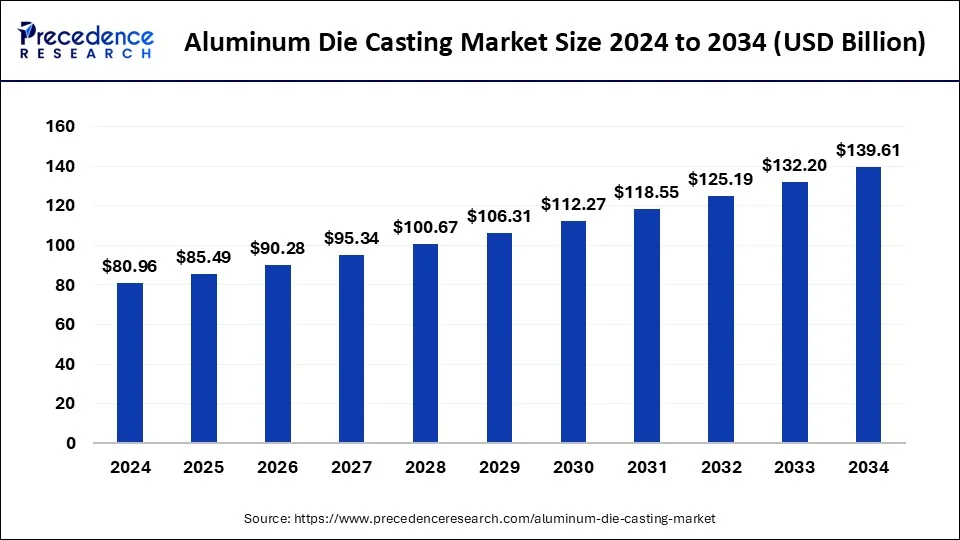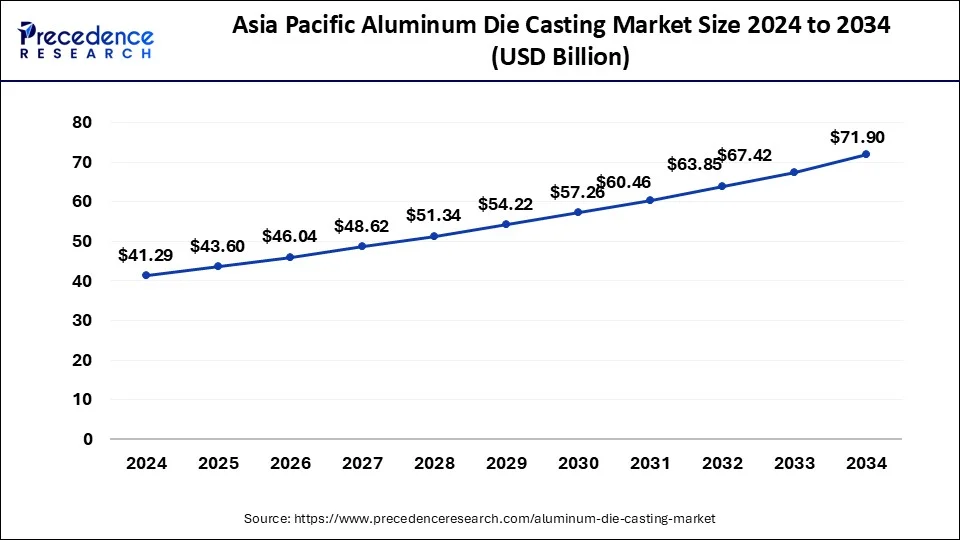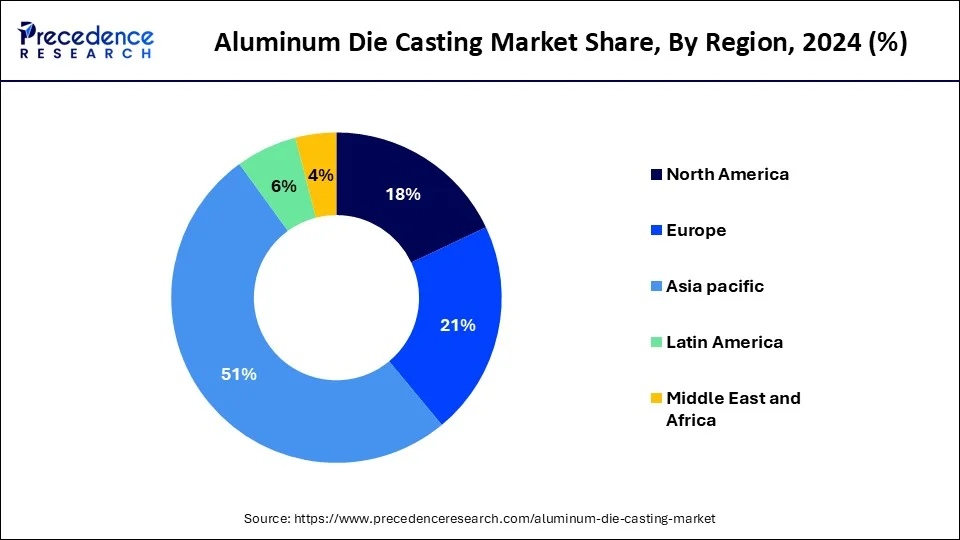September 2024
The global aluminum die casting market size is calculated at USD 85.49 billion in 2025 and is forecasted to reach around USD 139.61 billion by 2034, accelerating at a CAGR of 5.60% from 2025 to 2034. The Asia Pacific aluminum die casting market size accounted for USD 43.60 billion in 2025 and is expanding at a CAGR of 5.70% during the forecast period. The market sizing and forecasts are revenue-based (USD Million/Billion), with 2024 as the base year.
The global aluminum die casting market size reached USD 80.96 billion in 2024, estimated at USD 85.49 billion in 2025, and is predicted to be worth around USD 139.61 billion by 2034, expanding at a CAGR of 5.60% from 2025 to 2034.

The Asia Pacific aluminum die casting market size was estimated at USD 41.29 billion in 2024 and is anticipated to reach around USD 71.20 billion by 2034, at a CAGR of 5.7% from 2025 to 2034.

Asia Pacific dominated the aluminum die casting market with the largest share in 2024. The market growth in the region is driven by the increasing presence of skilled labor, low labor costs, and the easy availability of raw materials, which makes it the leading region for manufacturers to build production facilities. China accounted for a major market share in 2023 and is one of the largest manufacturing hubs across the globe. Moreover, the rising industrialization in the region contributed to the regional market expansion.

North America is expected to grow at the fastest rate during the forecast period. The abundant skilled labor at a low cost distinguishes the region, making it the most attractive location for firms seeking to establish industrial facilities. Moreover, the region is known for innovative technologies in manufacturing processes. Thus, the rising technological advances in aluminum die casting production methods and the increasing demand from the automotive industry further propel the market in the region.
The aluminum die casting market deals with the process of making complex aluminum parts using a specific die, die casting machine, metal, and a furnace. Aluminum die casting is a method of producing aluminum products in desired shapes by pouring molten metal into a mound of the appropriate shape and size, yielding a finished product that meets the requirements. The output product of aluminum die casting is obtained by pouring metals under high pressure or injecting metal into the mound cavity. When extreme precision, complicated pieces, and precise details are required, the aluminum die casting process is preferred.
The qualities of aluminum, such as resistance to corrosion, increase the feasibility of aluminum die casting products for a variety of applications. The automobile industry is a major user of aluminum die casting products, and the industry’s continued growth in manufacturing and sales may provide prospects for the aluminum die casting market to expand.
The aluminum alloys are melted in the furnace and then injected into the dies. Alloy 380.0 is widely used for dying casting and can cast aluminum alloys 413, 390, and 360. They also act as a metal surface coating that displays excellent corrosion resistance. The increasing usage of aluminum in several applications, such as telecommunication and transportation, is estimated to drive market growth. A rising preference for lightweight castings and high strength is also a major driving factor. Manufacturers are required to adhere to the regulations to reduce harmful emissions and enhance fuel efficiency in the transportation industry, which is further expected to drive the growth of the aluminum die casting market.
| Report Coverage | Details |
| Market Size in 2024 | USD 80.96 Billion |
| Market Size in 2025 | USD 85.49 Billion |
| Market Size by 2034 | USD 139.61 Billion |
| Growth Rate From 2025 to 2034 | CAGR of 5.6% |
| Largest Market | Asia Pacific |
| Fastest Growing Market | North America |
| Base Year | 2024 |
| Forecast Period | 2025 to 2034 |
| Segments Covered | Production Process, Application, Geography |
| Regions Covered | North America, Asia Pacific, Europe, Latin America, Middle East and Africa |
Increasing demand for automobiles and consumer goods
The aluminum die casting market’s growth is being supported by increased demand for automobiles and consumer products. The rising usage of aluminum die casting for various purposes and acceptance of high-strength and lightweight castings, notably in the auto sector, are among the primary drivers driving the market's expansion. Furthermore, a growth in the substitution of aluminum for iron and steel in the automotive sector, as well as increased funding in this sector, propel the market during the forecast period.
Furthermore, the automotive industry’s need for lightweight materials has been significantly influenced by the swift implementation of stringent government regulations. These regulations aim to lower emissions and improve fuel efficiency, and the market is responding by increasingly using highly accurate machines and gadgets to improve the quality and durability of aluminum casts for various applications as casting technology advances.
Rising use in construction applications
Aluminum castings are extensively used in construction applications. Aluminum die castings are popular in various construction applications due to their enhanced properties, such as being lightweight and high-strength. Aluminum casting is commonly used for gazed structures and window structures ranging from shop fronts to large roof superstructures for other shopping centers. They are also used for cast door handling, curtain walling, siding, and roofing. In addition, aluminum die casting is environmentally friendly, peel-resistant, scratch-resistant, and lightweight. These major factors are driving the growth of the aluminum die casting market during the forecast period.
Availability of alternative materials
As there are numerous reasons that can cause the aluminum die casting market to grow, there are also some factors that can limit the market growth. One of the most significant disadvantages of aluminum die casting is the entrapment of gases in the aluminum due to permeability, which can cause product deformation and damage. Furthermore, the aluminum die casting method is not ideal for the design of large parts, making it unsuitable for large parts.
However, the increasing substitution of aluminum alloys with magnesium, as well as the economic crisis in developed countries, is among the key factors restraining the growth of aluminum die casting market during the forecast period. In addition, fluctuations in raw material prices and easy availability of substitutes are further restraining the growth of the aluminum die casting market.
Internet of Things and Industry 4.0
The Internet of Things and Industry 4.0 are transforming the manufacturing industry. By leveraging these technologies, companies can improve product quality, reduce costs, and enhance productivity. IoT technology can monitor every step of the aluminum die casting procedure, from melting the metal to cooling the mold. IoT sensors help to collect information on variables such as humidity, temperature, and pressure. This data may be studied in real-time and enable producers to detect defects immediately and alter the procedure to ensure constant quality. In addition, with the help of Industry 4.0 technologies, automation of the aluminum die-cast tooling process is possible. Robotics can be utilized to complete this since they can be trained to carry out activities such as extracting the final piece from the mold and pouring molten metal into a mold. Furthermore, Industry 4.0 and IoT innovations can enhance the aluminum die casting tooling procedures, resulting in cost savings for manufacturers, enhanced quality of products, and higher productivity, which are further expected to drive the growth of the aluminum die casting market in the coming years.
The pressure die casting segment led the market with the largest share in 2024. The process’s notable advantages, such as fast cavity filling, flawless surface finish, high mechanical capabilities, and lower dimension tolerance, contributed to the segment's dominance. This process is more cost-effective and versatile than others. Moreover, reduced material waste and high precision associated with this process further boost its demand, particularly in the automotive industry.
On the other hand, the others segment is estimated to be the most opportunistic segment during the forecast period. Vacuum and squeeze die casting are two other methods of die casting. These methods are used to cast solar sensors and turbine blades. The rising usage of solar devices contributes to segmental growth.
The transportation segment accounted for the largest market share in 2024. This is mainly due to the rising demand for lightweight vehicles. Moreover, aluminum die casting is corrosion-resistant and possesses a high strength-to-weight ratio, allowing manufacturers in the transportation industry to design lightweight components, which significantly improves vehicles' fuel efficiency.
On the other hand, the industrial segment is expected to expand at the highest CAGR during the forecast period. Agriculture, mining, and construction equipment all fall under this category. Aluminum cast products are used in the components of the above-mentioned machinery. Rising industrialization further contributes to segmental growth.
By Production Process
By Application
By Geography
For inquiries regarding discounts, bulk purchases, or customization requests, please contact us at sales@precedenceresearch.com
No cookie-cutter, only authentic analysis – take the 1st step to become a Precedence Research client
September 2024